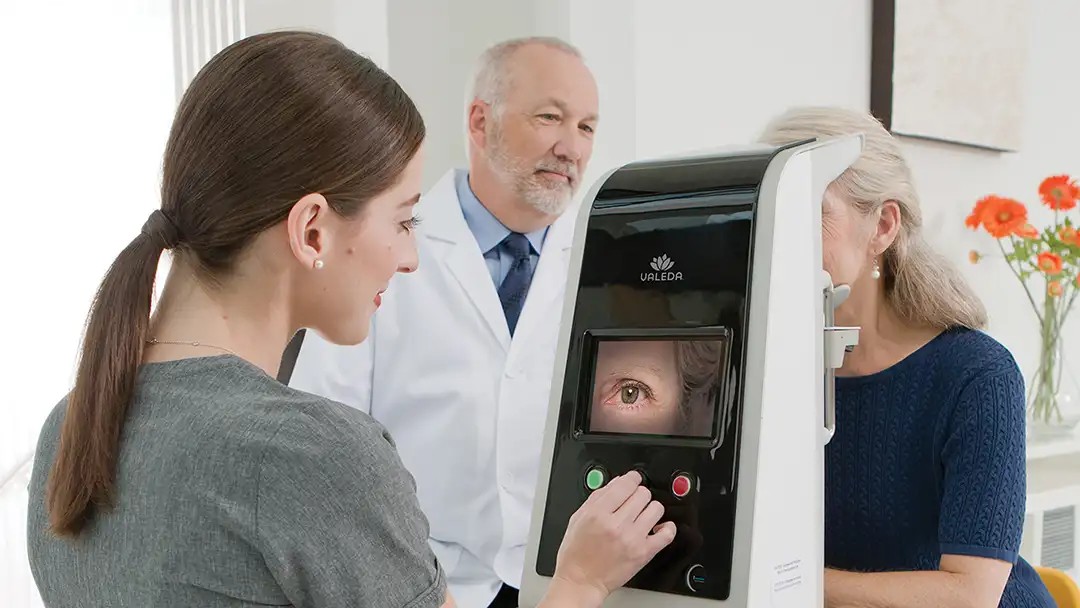
Learn about the symptoms of wet AMD, an eye disorder that can cause rapid vision loss.
Wet AMD is caused by new blood vessels leaking fluid into the retina. This causes the retina to become “wet.” Initially, the fluid causes reversible vision loss, but the vision loss can become permanent within weeks to months, if untreated. Thus, it’s very important to detect wet AMD.
Patients with wet AMD may be diagnosed with early-stage dry AMD years before the wet AMD occurs.
Early AMD has only subtle symptoms (see the article on “Symptoms of Dry AMD”), and is best diagnosed with a dilated eye exam. It usually occurs at age 55 or older, which is one reason why people in this age group should have a dilated eye exam every year or two.
The symptoms of the vision loss from wet AMD can come on suddenly, even within one day, when blood vessels suddenly leak into the retina. The process is painless. The symptoms are distortion or a blind spot in the central vision. The blind spot can appear gray, red, or black.
One way to detect distortion or a blind spot in the central vision is with an Amsler grid. The grid should be viewed with reading glasses on, held at a comfortable reading distance, and one eye should be tested at a time while the other eye is closed or covered. If the lines in the grid appear wavy or an area of lines is missing, call an ophthalmologist promptly.
Also, the ForeseeHome Monitor® from Notal Vision® is the first FDA-cleared device for patients with dry AMD to monitor the disease at home. It is now a Medicare-covered service for patients enrolled in Medicare across the U.S., and who meet the eligibility criteria for dry AMD at high risk for converting to wet AMD.
It sometimes can be difficult to distinguish a central blind spot from “floaters.” Floaters are opaque specks that float about in the vitreous region (the clear jelly-like substance that fills the eye from the lens to the back of the eye) and cast a shadow on the retina. They are very common. Floaters will continue to move slightly later than the movement of the eye, so if the eye is moved quickly, the floater, and dark spot or “blob” that it causes in your vision will continue to move for about a second after the eye is still. Usually, floaters are not a problem, but new floaters, especially if accompanied by flashing lights in the peripheral (side) vision or a “curtain” blocking the peripheral vision can be caused by a retinal detachment and should lead to an immediate call to an ophthalmologist.
Fortunately, wet AMD can now be treated with medicines injected into the eye which stop the abnormal blood vessels from leaking. These medications work best if the wet AMD is detected promptly!
About BrightFocus Foundation
BrightFocus Foundation is a premier global nonprofit funder of research to defeat Alzheimer’s, macular degeneration, and glaucoma. Since its inception more than 50 years ago, BrightFocus and its flagship research programs—Alzheimer’s Disease Research, Macular Degeneration Research, and National Glaucoma Research—has awarded more than $300 million in research grants to scientists around the world, catalyzing thousands of scientific breakthroughs, life-enhancing treatments, and diagnostic tools. We also share the latest research findings, expert information, and resources to empower the millions impacted by these devastating diseases. Learn more at brightfocus.org.
Disclaimer: The information provided here is a public service of BrightFocus Foundation and is not intended to constitute medical advice. Please consult your physician for personalized medical, dietary, and/or exercise advice. Any medications or supplements should only be taken under medical supervision. BrightFocus Foundation does not endorse any medical products or therapies.
- Disease Biology
- Eye Health
- Treatments
- Wet AMD









